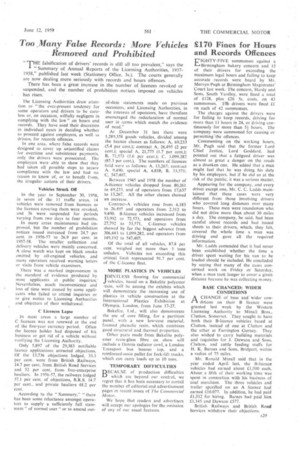Too _Many False Records: More Vehicles Removed and Prohibited
Page 31

If you've noticed an error in this article please click here to report it so we can fix it.
"!J" THE falsification of drivers' records is still all too prevalent," says the 'HE Summary of Annual Reports of the Licensing Authorities, 19571958," published last week (Stationery Office, 3s.), The courts generally arc now dealing more seriously with records and hours offences. There has been a great increase in the number of licences revoked or suspended, and the number of prohibition notices imposed on vehicles has risen.
The Licensing Authorities draw attention to "the ever7present tendency for some operators and drivers to be careless or, on occasion, wilfully negligent in complying with the law" on hours and• records. They have used their discretion in individual cases in deciding whether to proceed against employers, as well as
drivers, for records offences. _
In one area, where false records were designed to cover up unjustified claims for overtime and subsistence payments, only the drivers were prosecuted. The employers were able to show that they had taken all possible steps to secure compliance with the law and had no reason to know of, or to benefit from, the irregular .actions of their drivers.
Vehicles Struck Off
In the year to September 30, 1958, in seven of the 11 traffic areas, 14 vehicles were removed from licences or the licences covering them were revoked, and 36 were suspended for periods varying from two days to four months. In many areas maintenance had improved, but the number of prohibition notices issued increased from 24.7 per cent. in 1956-57 to 26.9 per cent, in 1957-58. The smaller collection and delivery vehicles were mainly concerned. A close watch was kept on black smoke emitted by oil-engined vehicles, and many operators received warning letters or visits from vehicle examiners. There was a marked improvement in the standard of evidence produced by most applicants at public inquiries:Nevertheless, much inconvenience and loss of time were caused by some applicants who failed to attend inquiries or to give notice to Licensing Authorities and objectors of their withdrawal.
C Licences Lapse , In most areas a large number of C licences was not renewed at the end of the five-year currency period. Often the licence holder had disposed of his business or got rid of a vehicle without notifying the Licensing Authority. Only 5,897 of the 29,383 notifiable licence applications attracted objections. Of the 13,736 objections lodged, 33.3 per cent. were from British Railways, 14.7 per cent. from British Road Services and 52 per cent. from free-enterprise hauliers. In 1956-57, the railways lodged 37.1 per cent, of objections, B.R.S. 14.7 per cent., and private hauliers 48.2 per cent. According to the "Summary," "there has been some reluctance amongst .operators to supply a sufficiently full statement" of normal user "or to amend out of-date statements made on previous occasions, and Licensing Authorities, in the interests of operators, have therefore encouraged the redeclaration of normal user in terms which match the evidence of need." At December 31 last there were 1,289,358 goods vehicles, divided among the licence classes as follows: A, 69,233 ,(5.4 per cent.); contract A, 26,495 (2 per cent.); special A, 21,775 (1.7 per cent.); B, 72,573 (5.6 per cent.); C, 1,099,282 (85.3 per cent.). The numbers of licences held were as follows: A, 13,267; contract A, 9.490; special A, 4,858; B. 33,571;
C, 547,407. Between 1945 and 1958 the number of A4icence vehicles dropped from 80,261 to 69,233, and of operators from 17,637 to 13,267. All the other classes showed an increase.
Contract-A vehicles rose from 6,183 to 26,495 and operators from 2,312 to 9,490. B-licence vehicles increased from 53,992 to 72,573, and operators from 27,792 to 33,571. C-licence vehicles showed by far the biggest advance from 306,443 to 1,099,282, and operators from 149,192 to 547,407. Of the total of all vehicles. 87.8 per cent, weighed not more than 3 tons unladen. Vehicles not exceeding this critical limit represented 91.7 per cent. of the C-licence fleet.
MORE PLASTICS IN VEHICLES
JOINTLESS flooring for commercial vehicles, based on a Bakelite polyester resin, will be among the exhibits which will demonstrate the increasing use of plastics in vehicle construction at the International Plastics Exhibition at Olympia, London, from June 17-27. Bakelite, Ltd., will also demonstrate the use of core filling, for a partition' panel, with a new lowcost material, foamed phenolic resin, which combines good structural and thermal properties. Other parts made from Bakelite polyester resin-glass fibre on show will include a Dennis radiator cowl, a London Transport bus bonnet top, and a reinforced-resin pallet for fork-lift trucks, which can carry loads up to 10 tons.
TEMPORARY DIFFICULTIES
BECAUSE of production difficulties which are beyond our control, we regret that it has been necessary to curtail the number of editorial and advertisement pages in recent issues of The Commercial Motor. We hope that readers and advertisers will accept our apologies for the omission of any of our usual features.




















































































